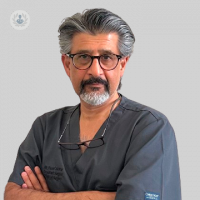How can I prevent the development of hernias?
Written in association with:In this article, distinguished consultant general surgeon, Mr Yousaf Akhtar, explains what hernias are, how they develop, and how they are treated.

What are hernias?
A hernia is an abnormal protrusion of part of a body part out of its normal area of confinement. It normally results in swelling, pain, and sometime loss of function. Most hernias involve one of your abdominal organs pushing through one of the walls of your abdominal cavity. Hernias can occur gradually as you get older and regular wear and tear on your muscles begins to add up. They can also result from an injury or surgery.
What are the different types of hernia?
The most common types of hernias include inguinal, umbilical, incisional, and hiatal hernias. Inguinal hernias, occurring in the groin area, are the most prevalent, especially among men. Umbilical hernias are located near the belly button and are common in infants, though they can also affect adults. Incisional hernias can develop at the site of a previous surgical scar, while hiatal hernias occur when part of the stomach pushes through the diaphragm into the chest cavity.
What causes hernias?
There are many causes of hernias. The most common are:
- A job that involves heavy lifting or many hours of standing.
- A chronic cough or allergies that cause chronic sneezing.
- Chronic constipation and straining to poop or pee.
- A history of abdominal or pelvic surgery.
- Pregnancy, especially repeat pregnancies.
- Chronic obesity (a body mass index, or BMI, greater than 30). and a family history of hernias also increase the risk.
Abdominal wall hernias are common, with a prevalence of 1.7% of all ages and 4% of those aged 45 and above. Inguinal hernias account for 74% of all abdominal hernias with a lifetime risk of 27% in men and 3% in females. Hernia repair surgery is one of the most common medical procedures.
What are the associated symptoms?
Symptoms of hernias can vary depending on their type and severity. Common signs include a noticeable bulge or lump in the affected area, which may become more apparent when standing up, bending over, or coughing. This bulge might be accompanied by discomfort or pain, especially when lifting or straining.
Sometimes, the hernia becomes stuck, which causes pain (incarcerated). Sometimes it becomes so bad that it can get strangulated. In severe cases, the tissue can become cut off from blood supply, causing necrosis (tissue death).
Since hernias tend to worsen over time, most will need surgical repair eventually. Incarcerated hernia should be operated urgently and strangulated ones as an emergency if the hernia becomes non-reducible (it is not going back). If it is very painful to touch, then it can be due to strangulation, which requires emergency surgery.
How are hernias treated?
Treating hernias typically involves surgery to repair the weakened area and prevent further protrusion. The two main surgical options are open hernia repair and laparoscopic hernia repair. Open hernia repair involves making an incision to push the protruding tissue back into place and reinforce the abdominal wall with stitches or mesh.
Laparoscopic hernia repair is a minimally invasive procedure that uses small incisions and a camera to guide the repair. This method generally results in faster recovery times and less postoperative pain.
The Royal college of Surgeons guidelines recommend that bilateral hernias should be operated on laparoscopically while unilateral can be operated on via an open repair. All groin and inguinal hernias are repaired with mesh. Other hernias repair depend on the size of the defect, whether to use mesh or simple repair with non-dissolving sutures.
How can I prevent the development of hernias?
Preventing hernias involves maintaining a healthy weight, avoiding heavy lifting, and practicing proper lifting techniques. Strengthening the abdominal muscles through regular exercise can also help.
If you suspect you have a hernia, it is important to seek medical attention promptly to prevent complications such as strangulation, where the blood supply to the herniated tissue is cut off, leading to a potentially life-threatening situation.
Hernia surgery is a common procedure that aims to repair a weakness or opening in the abdominal muscles. Though it can provide relief for those suffering from hernias, as with any operation, there are risks involved. Understanding the benefits and risks of hernia surgery is essential before deciding whether to undergo the procedure.
To book an appointment with Mr Yousaf Akhtar today, visit his Top Doctors profile.


